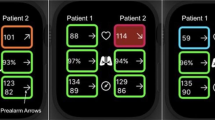Abstract
People make hundreds of decisions every day. Rather than optimize those decisions by gathering pertinent information, people instead rely on routines. While those routines are usually sufficient, they do occasionally fail. Those failures present an opportunity to improve decision-making by providing low-cost information when and where people start to follow their routines. We conducted a study to examine the routines that users follow at night and in the morning. Drawing on the results, we created a next-generation alarm clock that highlights unusual situations to help users determine when and how to modify their routines to more effectively decide on an alarm time, what to wear, when to get out of bed, and when to leave for work.





Similar content being viewed by others
References
Cadiz J, Venolia G, Jancke G, Gupta A (2002) Designing and deploying an information awareness interface. In: Proceedings of CSCW 2002, New Orleans, Louisiana, pp 314–323
Dourish P, Bly S (1992) Portholes: supporting awareness in a distributed work group. In: Proceedings of CHI 1992, Monterey, California, pp 541–547
Horvitz E, Jacobs A, Hovel D (1999) Attention-sensitive alerting. In: Proceedings of the 1999 conference on uncertainty and artificial intelligence, Stockholm, Sweden, July 1999, pp 305–313
Horvitz E (1999) Principles of mixed-initiative user interfaces. In: Proceedings of CHI 1999, Pittsburgh, Pennsylvania, May 1999, pp 159–166
Heiner J, Hudson S, Tanaka K (1999) The information percolator: ambient information display in a decorative object. In: Proceedings of UIST 1999, Asheville, North Carolina, November 1999, pp 141–148
Hull R, Neaves P, Bedford-Roberts J (1997) Towards situated computing. In: Proceedings of ISWC 1999, Cambridge, Massachusetts, October 1997, pp 146–153
Hunt D RISE alarm clock. http://www.brunel.ac.uk/faculty/tech/PressNewsClock.htm
Ishii H, Wisneski C, Brave S, Dahley A, Gorbet M, Ullmer B, Yarin P (1998) AmbientROOM: integrating ambient media with architectural space. In: CHI 1998 conference summary, Los Angeles, California, April 1998, pp 173–174
McCrickard DS, Chewar CM (2003) Attuning notification design to user goals and attention costs. Commun ACM 46(3):67–72
Microsoft smart watches with MSN direct. http://direct.msn.com/
Miller T, Stasko J (2002) Artistically conveying peripheral information with the InfoCanvas. In: Proceedings of AVI 2002, Trento, Italy, May 2002, pp 43–50
Navigator, The Georgia Department of Transportation’s intelligent transportation system. http://www.georgianavigator.com
Norman DA (1998) The invisible computer: why good products can fail, the personal computer is complex, and information appliances are the solution. MIT Press, Cambridge
Rieman J (1993) The diary study: a workplace-oriented research tool to guide laboratory efforts. In: Proceedings of CHI 1993, Amsterdam, The Netherlands, pp 321–326
Suchman L (1987) Plans and situated actions: the problem of human-machine communication. Cambridge University Press, New York
Thomas P, Meech J, Marcredie R (1995) A framework for the development of information appliances. In: Proceedings of the 1995 ACM symposium on applied computing, Nashville, Tennessee, February 1995, pp 396–400
Tversky A, Kahneman D (1974) Judgement under uncertainty: heuristics and biases. Science 185:1124–1131
van Dantzich M, Robbins D, Horvitz E, Czerwinski M (2002) Scope: providing awareness of multiple notifications at a glance. In: Proceedings of AVI 2002, Trento, Italy, May 2002, pp 161–168
Weiser M, Brown J (1996) The coming age of calm technology. http://www.ubiq.com/hypertext/weiser/acmfuture2endnote.htm
Wensveen S, Overbeeke K (2001) Adapting through behaviour: what my alarm clock should know, do and feel. In: Proceedings of the 2001 international conference on affective human factors design, Singapore, June 2001, pp 242–247
Zhao Q, Stasko J (2002) What’s happening?: promoting community awareness through opportunistic, peripheral interfaces. In: Proceedings of AVI 2002, Trento, Italy, May 2002, pp 69–74
Acknowledgements
We thank Microsoft Research for their hardware donation.
Author information
Authors and Affiliations
Corresponding author
Rights and permissions
About this article
Cite this article
Landry, B.M., Pierce, J.S. & Isbell, C.L. Supporting routine decision-making with a next-generation alarm clock. Pers Ubiquit Comput 8, 154–160 (2004). https://doi.org/10.1007/s00779-004-0274-y
Received:
Accepted:
Published:
Issue Date:
DOI: https://doi.org/10.1007/s00779-004-0274-y




